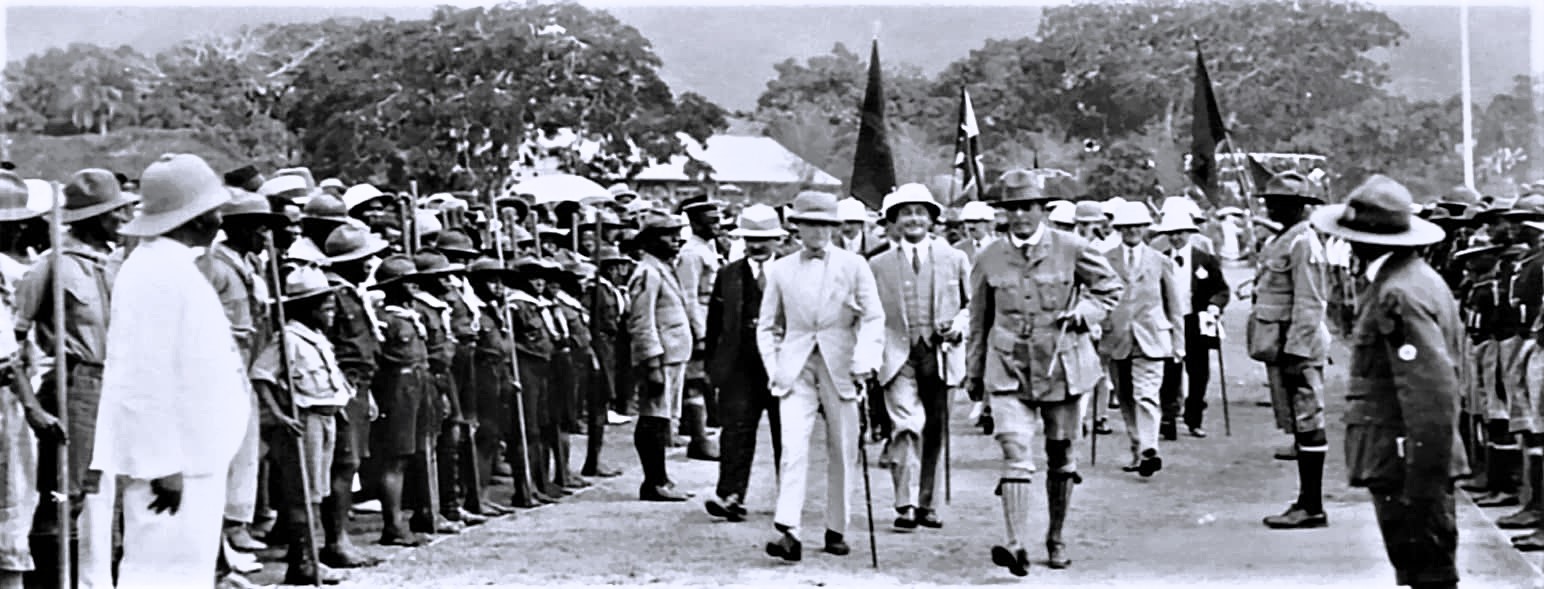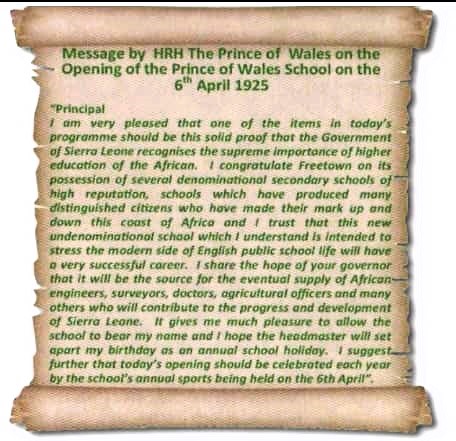School History

The Prince of Wales School Foundation Podcast
0:00s
A Royal Transformation: The Prince of Wales and a New Identity
In 1917, the Government Model School in colonial Freetown was a crucial early education center, shaping young minds like Sylvanus Juxon-Smith under influential figures like E.W.B. Cole. By 1922, the educational landscape evolved with the establishment of the Government Secondary School within the same premises, attracting dedicated educators and emphasizing academic excellence. Recognizing the need for a permanent location, the government acquired land in Kingtom, transforming a former coaling station into a modern facility, and in October 1924, the school relocated. A pivotal moment arrived in April 1925 with the visit of the Prince of Wales, who officially opened the school and renamed it The Prince of Wales School, marking April 6th as its foundation day.

The Genesis of the Prince of Wales School
Our story begins in the heart of colonial Freetown, a melting pot of cultures and ambitions. Within this bustling environment, the Government Model School stood as a cornerstone of early education. Imagine the year 1917, a time of global upheaval, yet within the walls of this school, young minds were being shaped. A particular student, Sylvanus Juxon-Smith, was absorbing knowledge under the guidance of E.W.B. Cole, a figure of profound influence who would later become the esteemed Reverend E.B. Cole. This period was not merely about rote learning; it was about cultivating intellectual curiosity and laying the groundwork for future leadership.
The Government Model School, under the stewardship of Reverend W.T. Thomas and Principal H. Evans, was more than just an educational institution; it was a crucible of intellectual growth. The curriculum was rigorous, the standards were high, and the emphasis was on producing well-rounded individuals. However, the winds of change were blowing. In 1922, the educational landscape shifted with the establishment of the Government Secondary School, a distinct entity housed within the same premises. This transition marked a significant step in the evolution of secondary education in Sierra Leone.
The newly formed Government Secondary School was a beacon of academic excellence, attracting a cadre of highly qualified educators. Figures like E.W. Turner, Revd. Ejesa Osora, and R.B. Mark brought with them a wealth of knowledge and a passion for teaching. Their presence elevated the school's academic standing and provided students with access to a world-class education. These were not just teachers; they were mentors, shaping the intellectual and moral character of their students.
Meanwhile, the colonial government recognized the need for a permanent home for this burgeoning institution. The search led them to Kingtom, a site steeped in history and potential. The land, formerly owned by the Sierra Leone Coaling Company, possessed a unique character, with its derelict jetty and sprawling grounds. This location, initially acquired by the Wesleyan Methodist Mission and then sold to the government, offered the space and potential for the school to flourish.
The transformation of the site was a testament to the government's commitment to education. The old coaling station underwent extensive repairs and refurbishments, transforming it into a modern educational facility. In October 1924, the momentous move from Circular Road to Hennessy Square took place. Picture the scene: Public Works Department lorries, laden with desks, blackboards, and eager students, making their way through the streets of Freetown. The students themselves were actively involved in the move, their excitement palpable as they helped transport the school's equipment. This was not just a relocation; it was a collective endeavor, a shared experience that fostered a sense of community and ownership.
The Government Secondary School at Hennessy Square was a vibrant hub of learning, but its identity was about to undergo a profound transformation. The arrival of His Royal Highness, The Prince of Wales, in April 1925, marked a pivotal moment in the school's history. The HMS Hood, a symbol of British naval power, anchored in Freetown, signaling the start of a royal visit that would leave an indelible mark on the school.
On April 6th, the school grounds were abuzz with anticipation. The Prince's arrival was a spectacle, a moment of grandeur and ceremony. He was greeted by Principal Evans and Head Prefect Mohammed Sanusi Mustapha, who presented him with a golden key, a symbol of authority and access. With this key, the Prince officially opened the school doors, ushering in a new era. The Prince's visit was not merely a ceremonial gesture; it was a personal engagement with the school and its students. He toured the facilities, including the science labs, observing the students' experiments and engaging with their learning. After Sanusi Mustapha's welcome address, the Prince made a significant announcement: the school would henceforth be known as The Prince of Wales School, its foundation day marked as April 6th, and sharing his birthday, June 23rd.
The Prince's personal touch was evident as he shook hands with each of the 117 students and then the faculty, all adorned in their academic regalia. A particularly poignant moment occurred when he reunited with Revd. Osora, his former Oxford contemporary, a reunion that spoke of shared experiences and intellectual camaraderie. The ceremony concluded with a resounding cheer for "Edward – The Prince of Wales," a testament to the students' admiration and the school's newfound identity. And let's not overlook Sylvanus Juxon-Smith, a key witness to this transformative journey, who was among the first students registered at the Prince of Wales School in January 1925. His presence serves as a bridge between the school's humble beginnings and its illustrious future. This expanded narrative paints a vivid picture of the Prince of Wales School's origins, highlighting the key figures, events, and transformations that shaped its identity and legacy. It's a story of ambition, dedication, and royal patronage, a narrative that continues to resonate with the school's alumni and the broader community.
